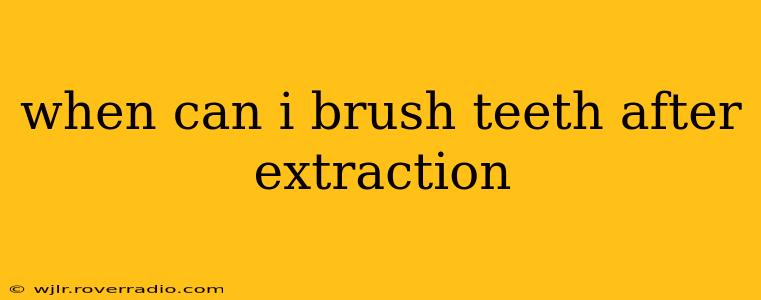Tooth extraction, while a common procedure, leaves your mouth vulnerable. Knowing when and how to brush your teeth afterward is crucial for proper healing and preventing complications. This guide will answer all your questions about oral hygiene post-extraction.
How Long Should I Wait to Brush After a Tooth Extraction?
The general recommendation is to wait at least 24 hours before brushing your teeth after a tooth extraction. This allows the initial blood clot to form, which is essential for healing and preventing a painful and potentially serious complication called dry socket. However, the specific timeframe might vary slightly depending on the complexity of the extraction and your dentist's instructions. Always follow your dentist's advice meticulously.
What Should I Do Immediately After the Extraction?
Immediately after the extraction, your dentist will likely place a gauze pad over the extraction site to control bleeding. Bite down firmly on this pad for at least 30-45 minutes, or as instructed. Avoid rinsing vigorously or spitting, as this could dislodge the blood clot. Gentle rinsing with saltwater might be recommended later, but only as directed by your dentist.
Can I Brush My Other Teeth After Extraction?
Yes, you can and should brush your other teeth as you normally would, starting as soon as possible after the extraction. Maintaining good oral hygiene in the rest of your mouth is crucial to prevent infection, which could impact the healing of the extraction site. Just be extremely careful around the extraction area.
How Should I Brush Near the Extraction Site After 24 Hours?
Once the 24-hour waiting period is over, you can gently resume brushing your teeth, but exercise extreme caution near the extraction site. Use a soft-bristled toothbrush and focus on gentle, circular motions. Avoid scrubbing aggressively, which could irritate the area and dislodge the blood clot. It's best to brush away from the extraction site, rather than directly on it.
What If I Have a Dry Socket?
A dry socket (alveolar osteitis) is a painful complication that can occur if the blood clot is dislodged from the extraction site. Symptoms include severe pain, a bad taste in your mouth, and sometimes a visible empty socket. If you suspect you have a dry socket, contact your dentist immediately. They can provide treatment to alleviate the pain and promote healing.
What Kind of Toothbrush Should I Use After an Extraction?
A soft-bristled toothbrush is recommended after a tooth extraction. Hard bristles can irritate the healing tissues and potentially dislodge the blood clot.
When Can I Use Mouthwash After Tooth Extraction?
Similar to brushing, it's best to avoid using mouthwash for at least 24 hours after a tooth extraction. The alcohol in many mouthwashes can irritate the extraction site and hinder the clotting process. After 24 hours, you can use a mild salt-water rinse as directed by your dentist. Avoid harsh, antimicrobial mouthwashes until healing is complete.
Can I Floss After a Tooth Extraction?
Avoid flossing near the extraction site for at least a week. Flossing too soon could dislodge the blood clot and increase the risk of infection or dry socket. You can continue to floss the rest of your teeth gently, avoiding the extraction site.
Remember: This information is for general guidance only. Always follow your dentist's specific post-operative instructions. They'll provide personalized advice based on your individual situation and the type of extraction performed. Regular check-ups are essential to monitor healing and address any concerns.
